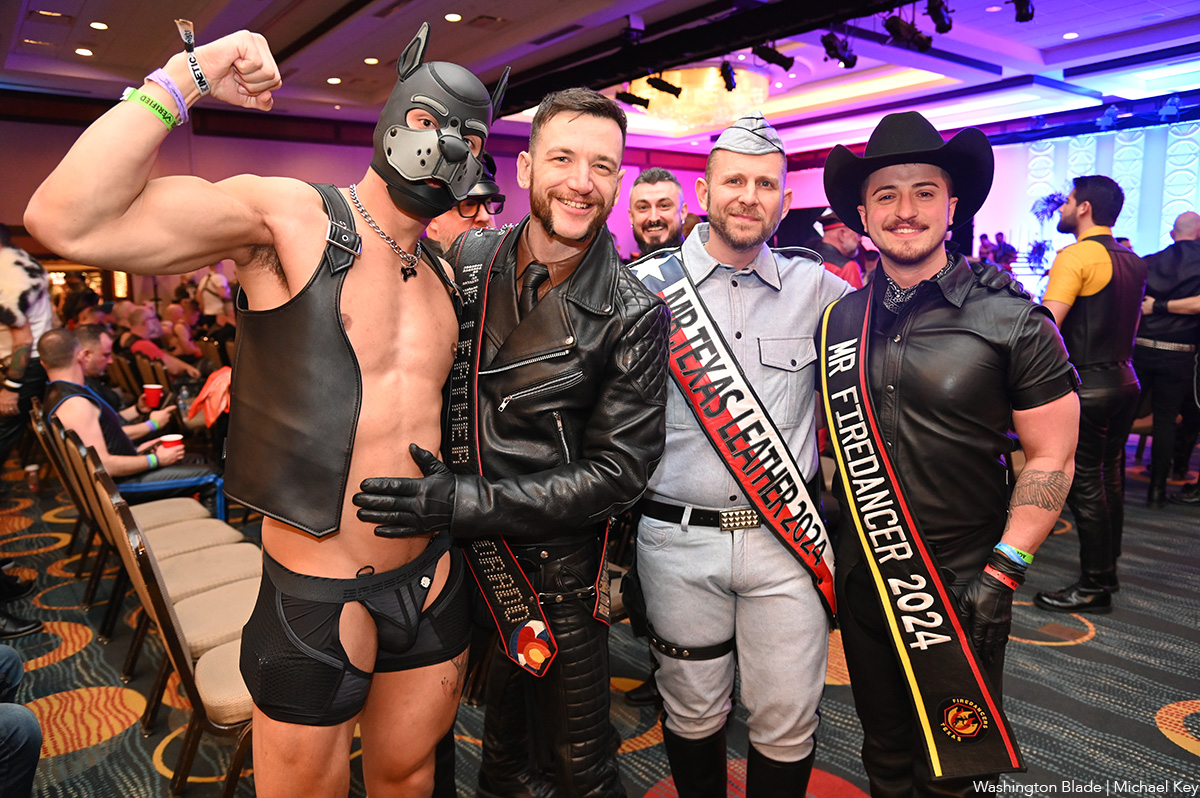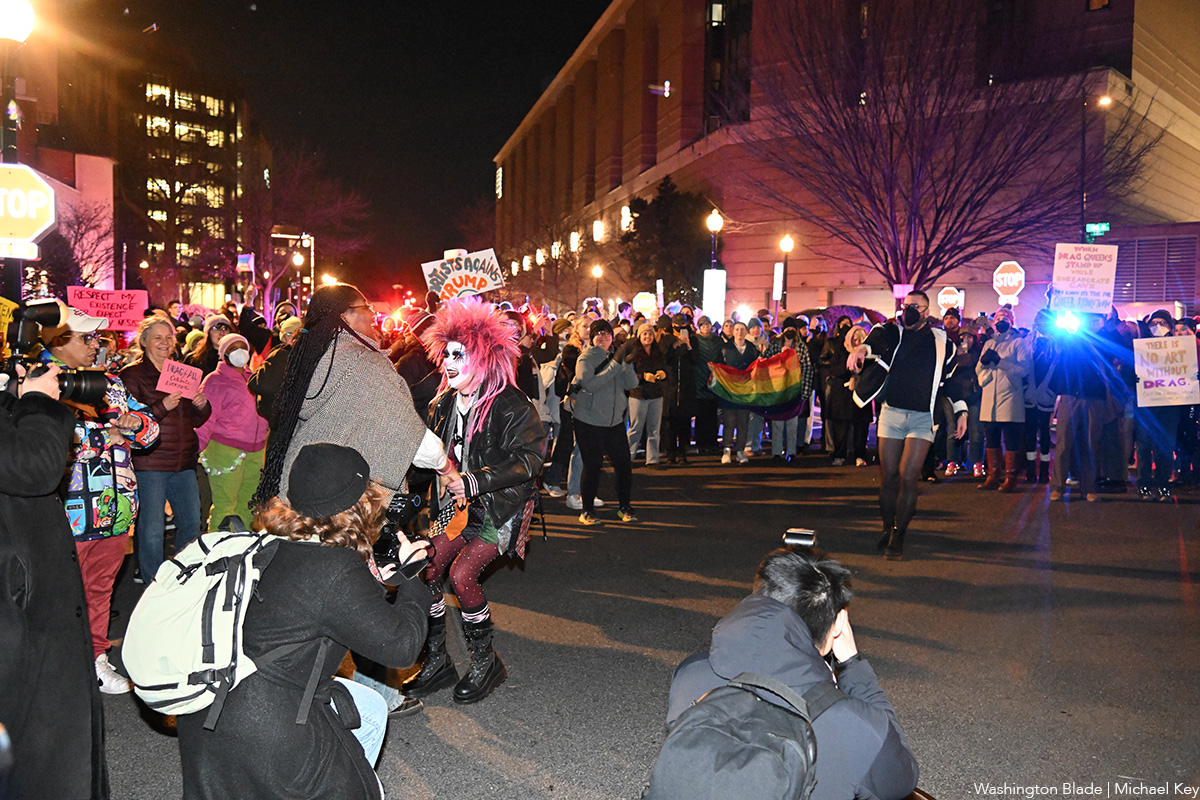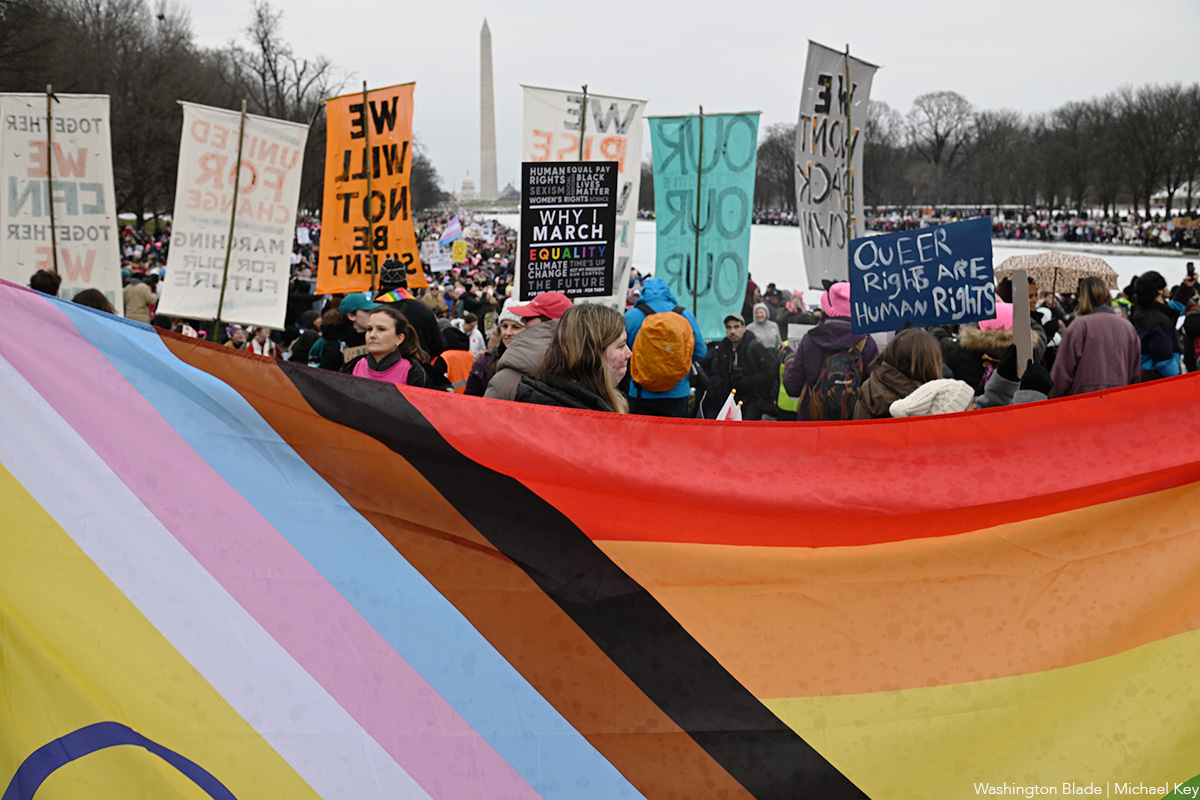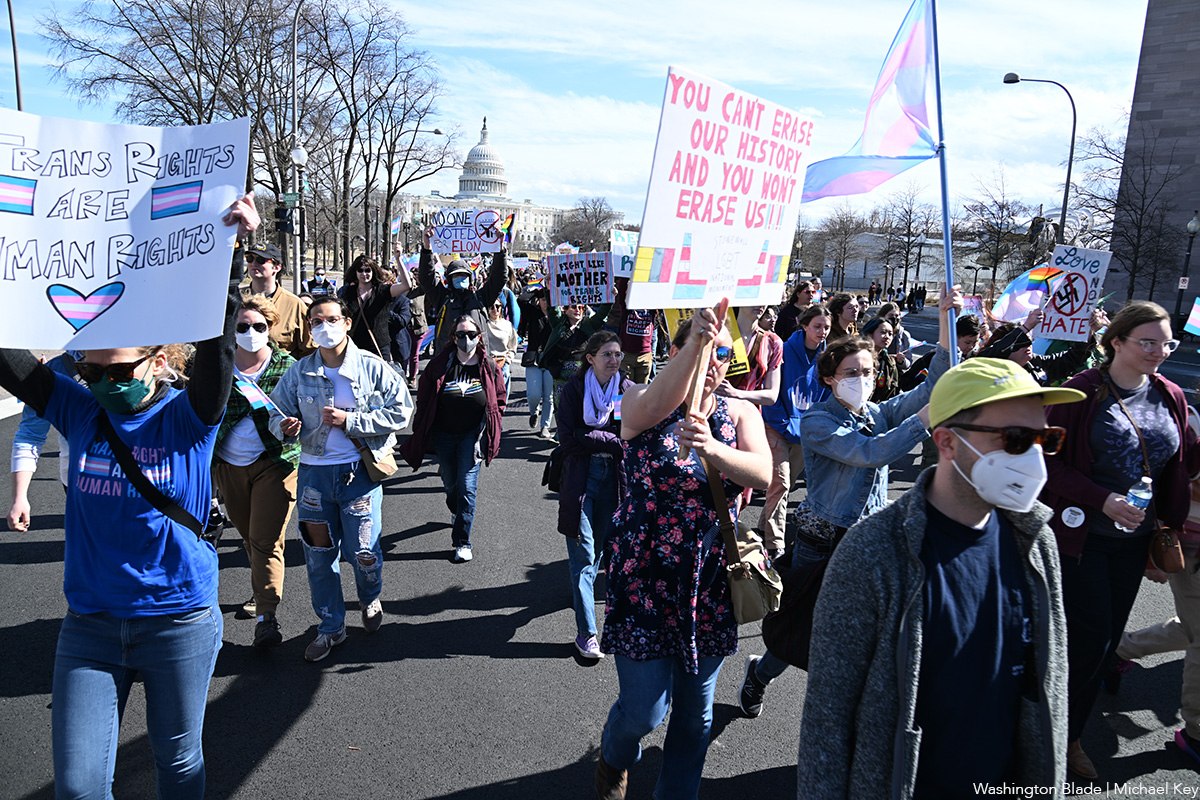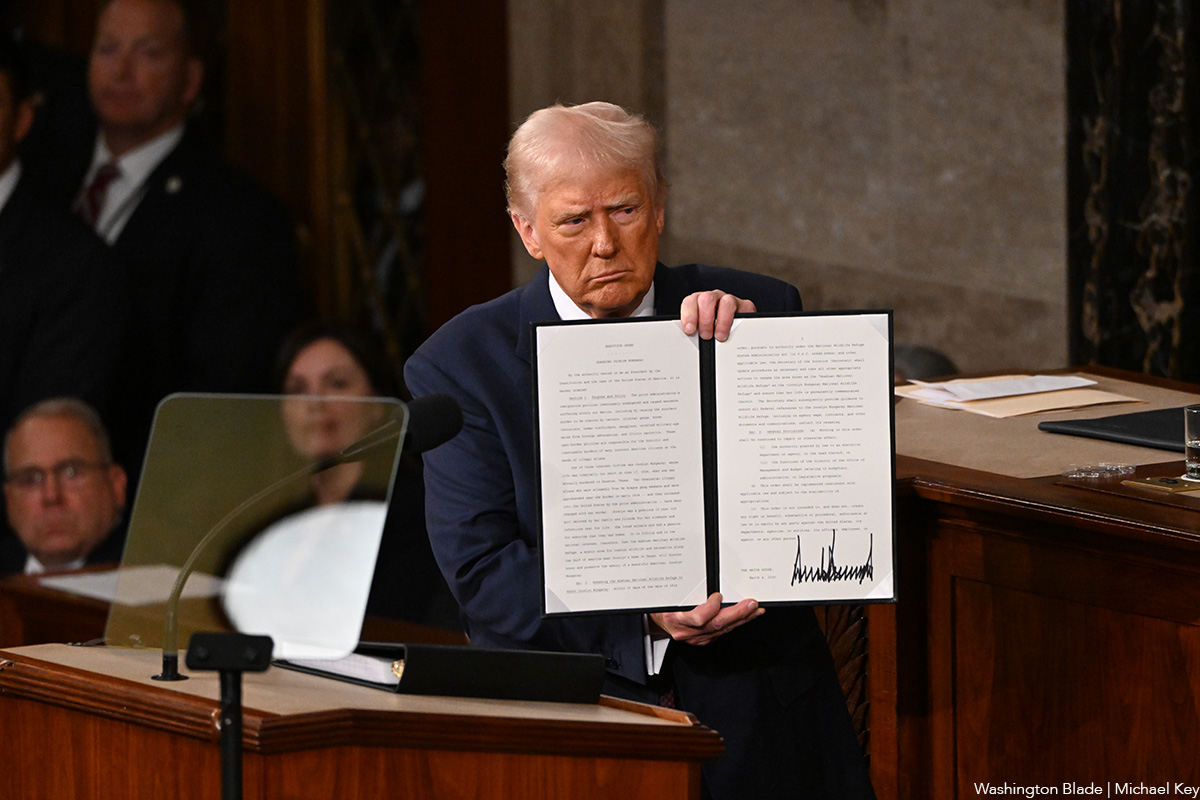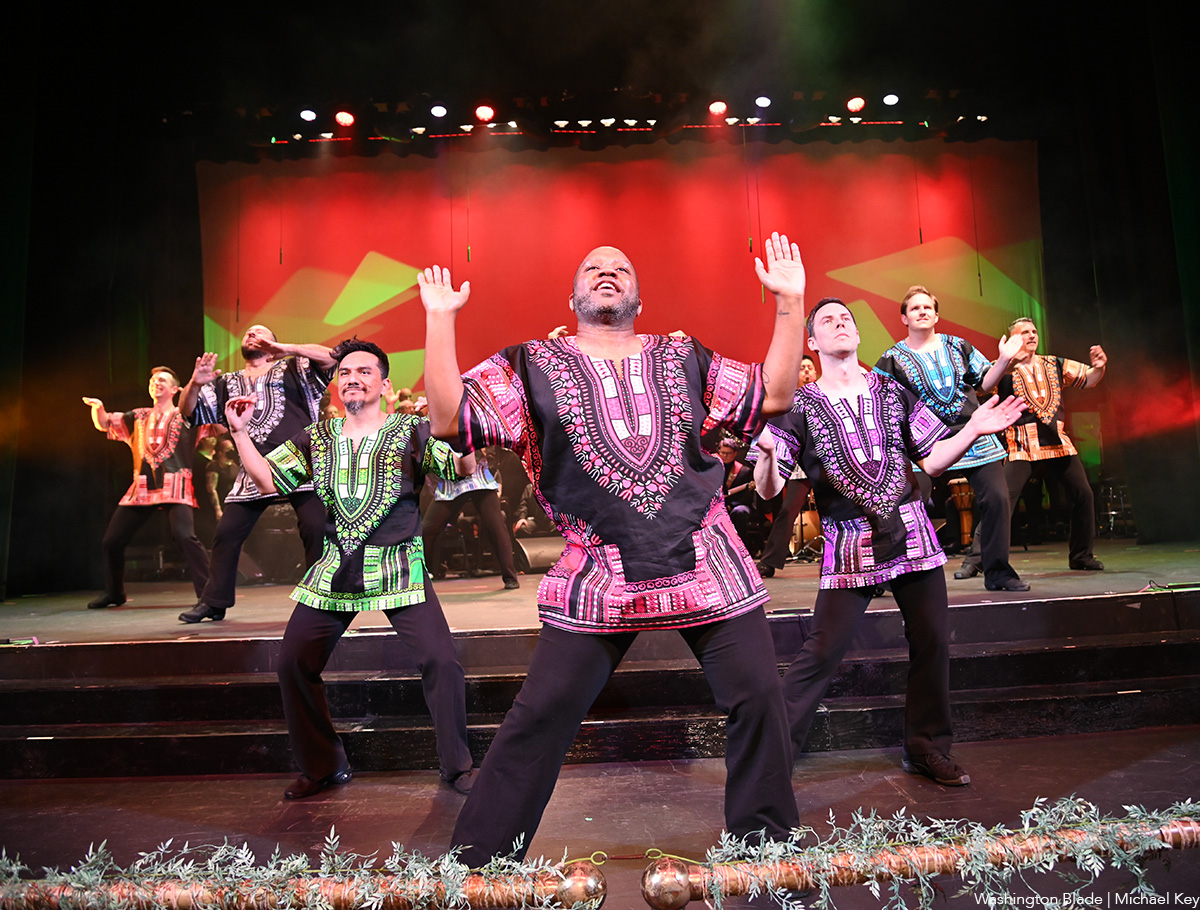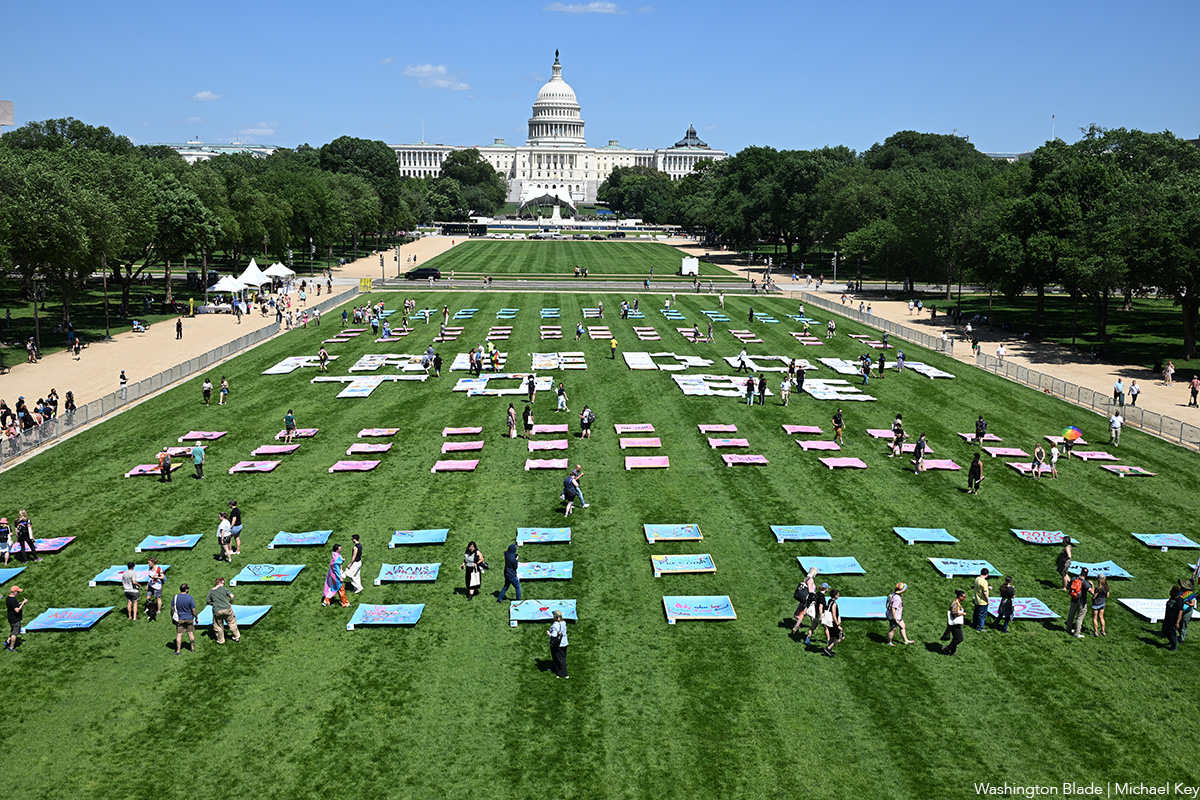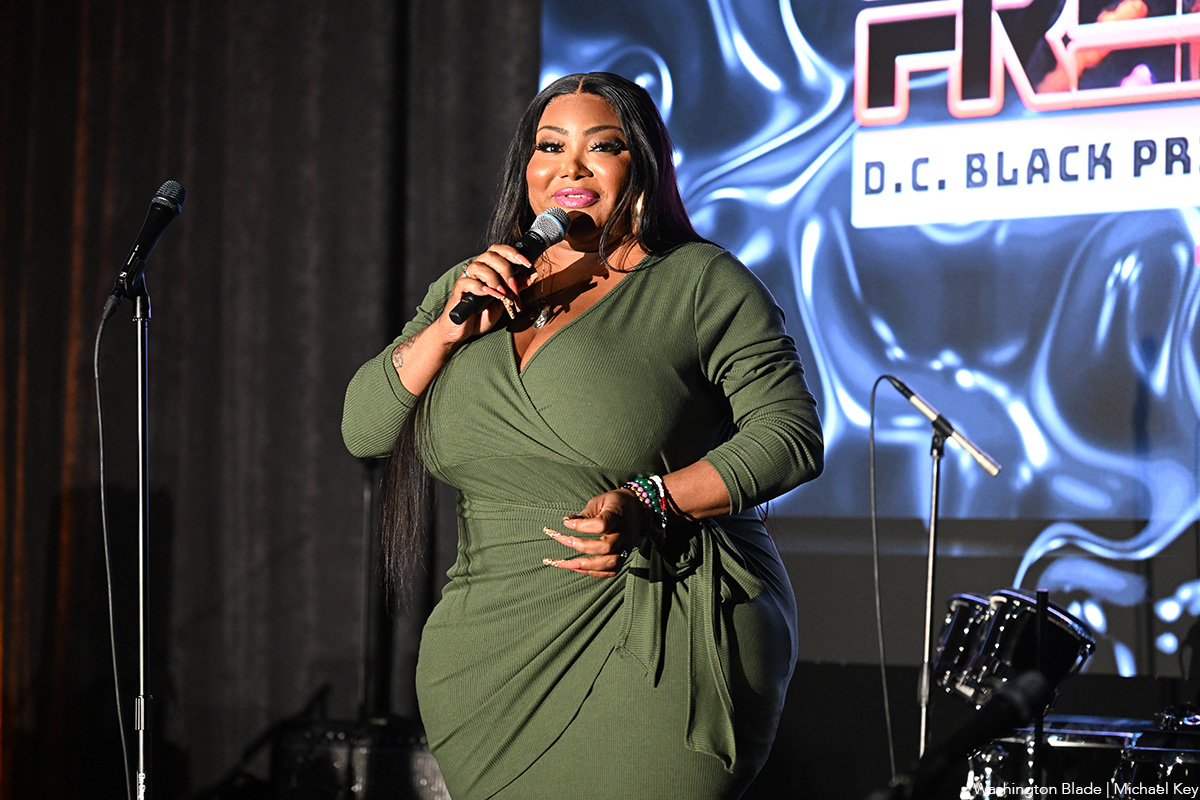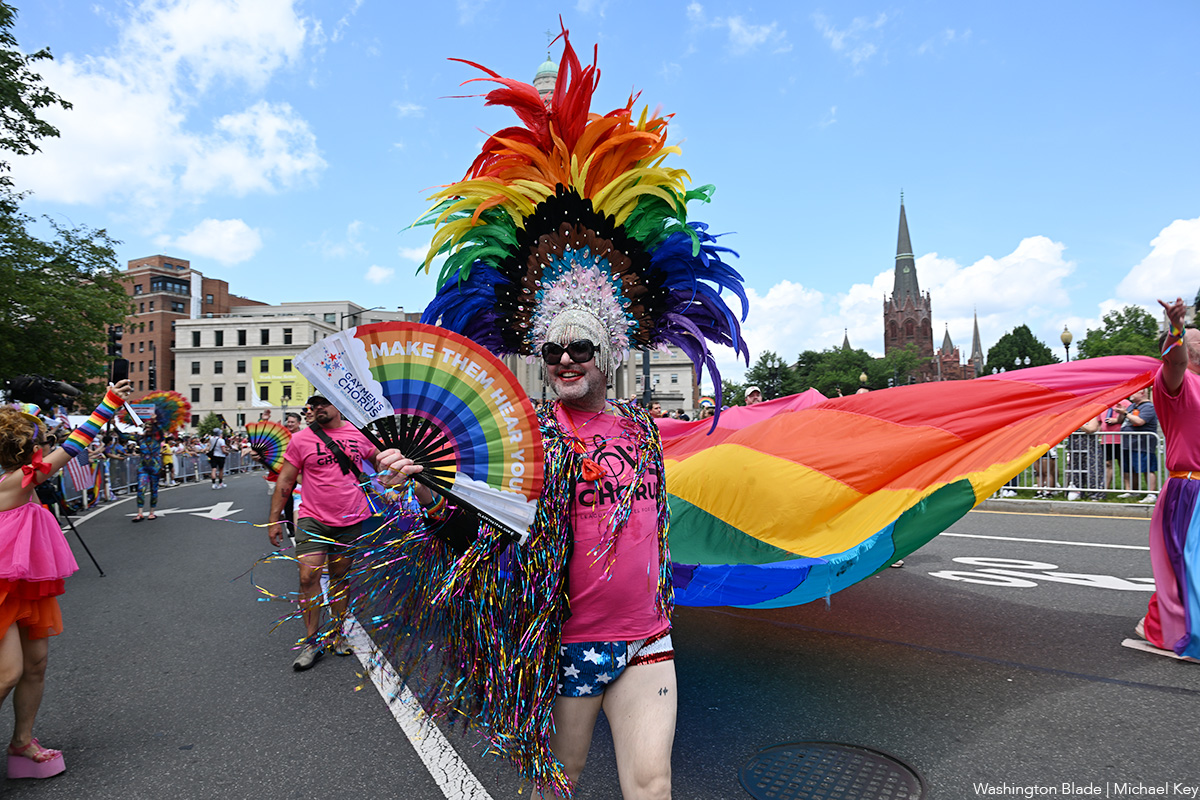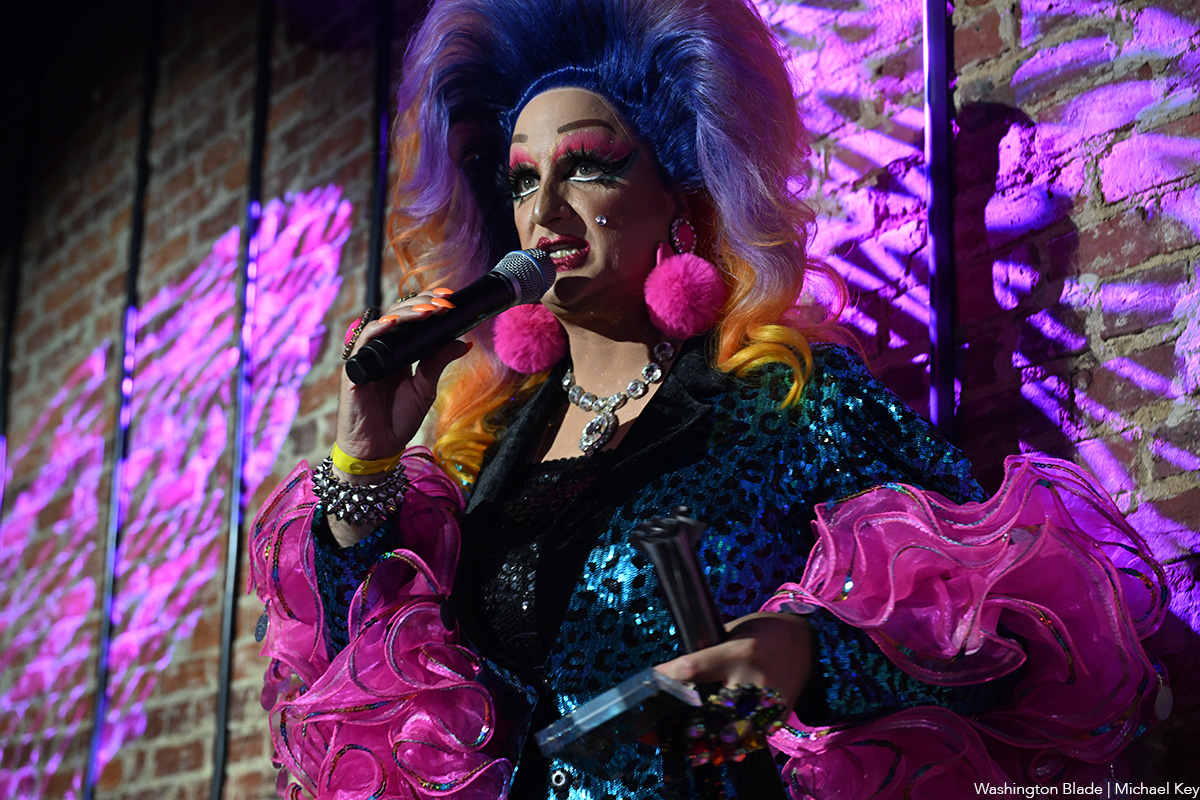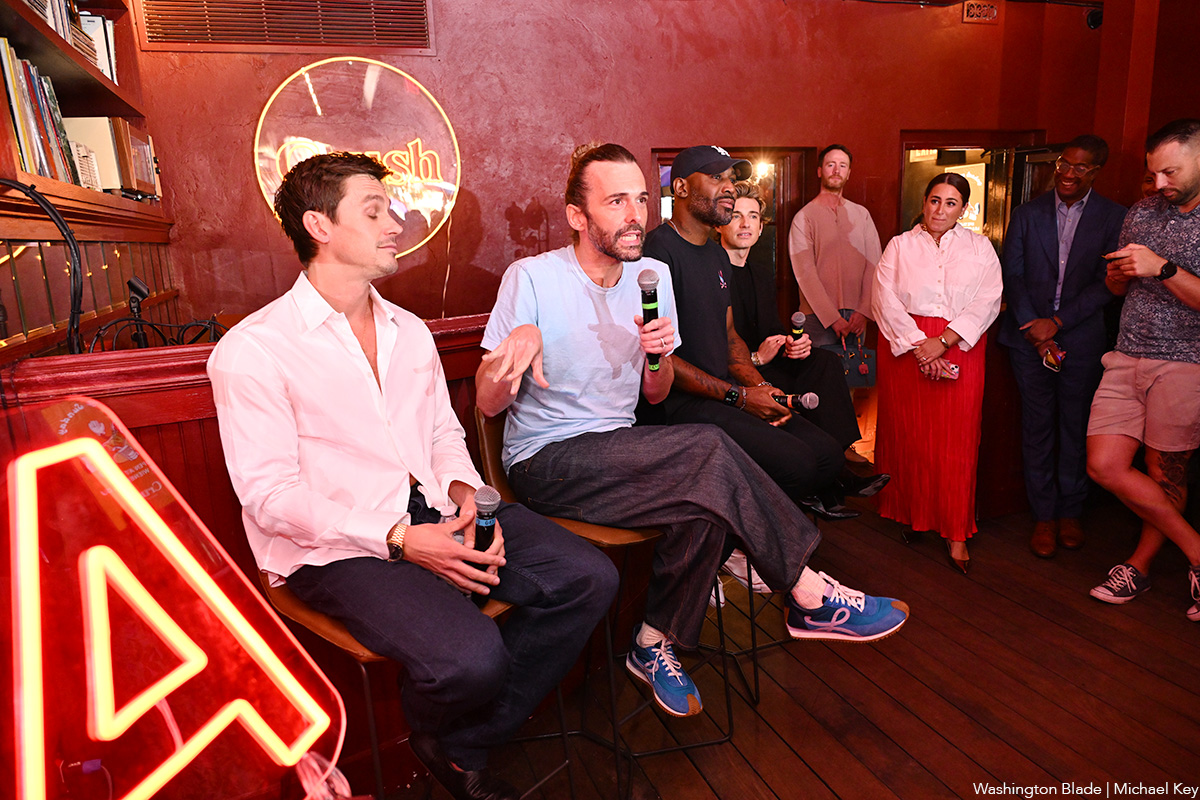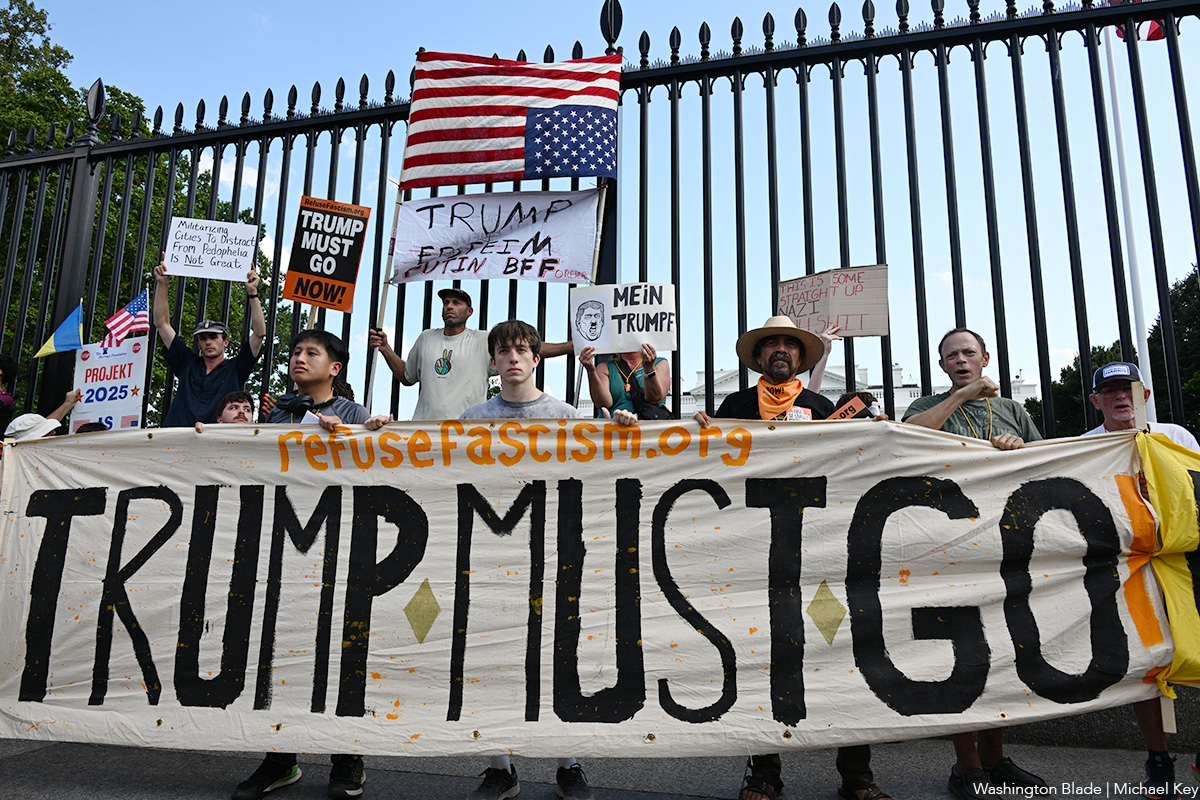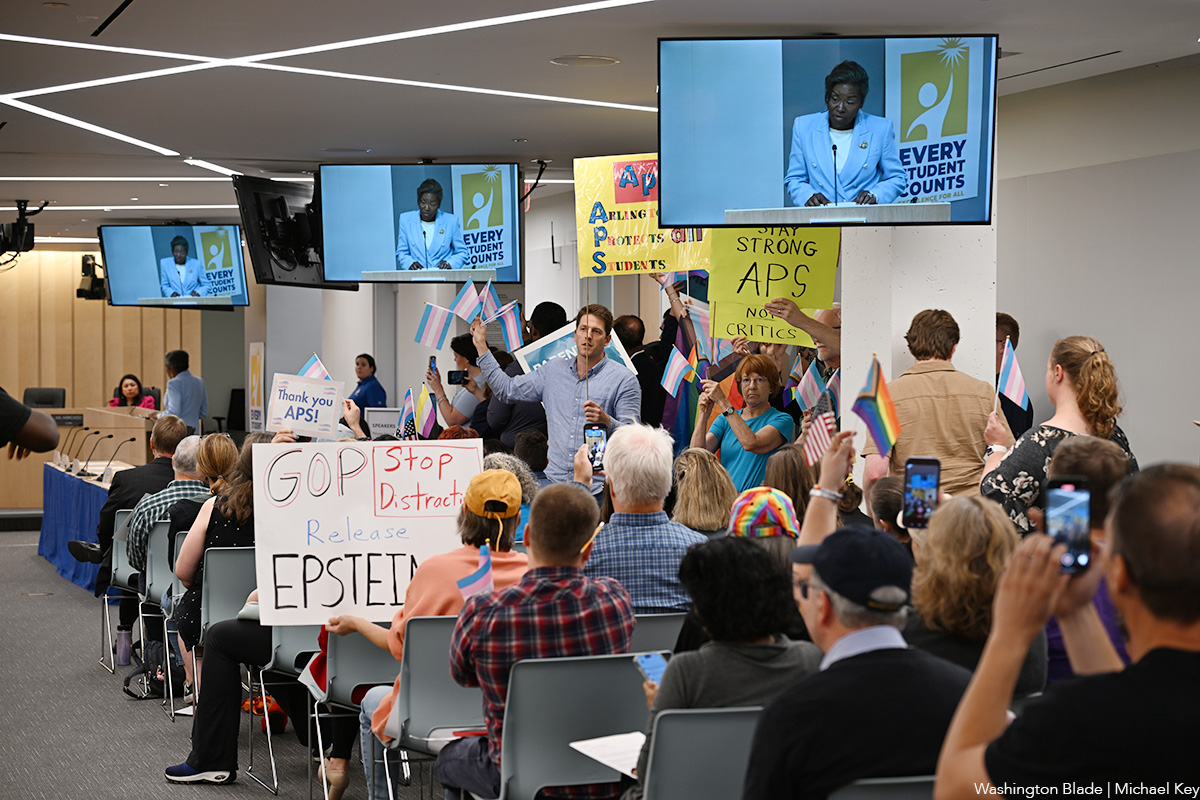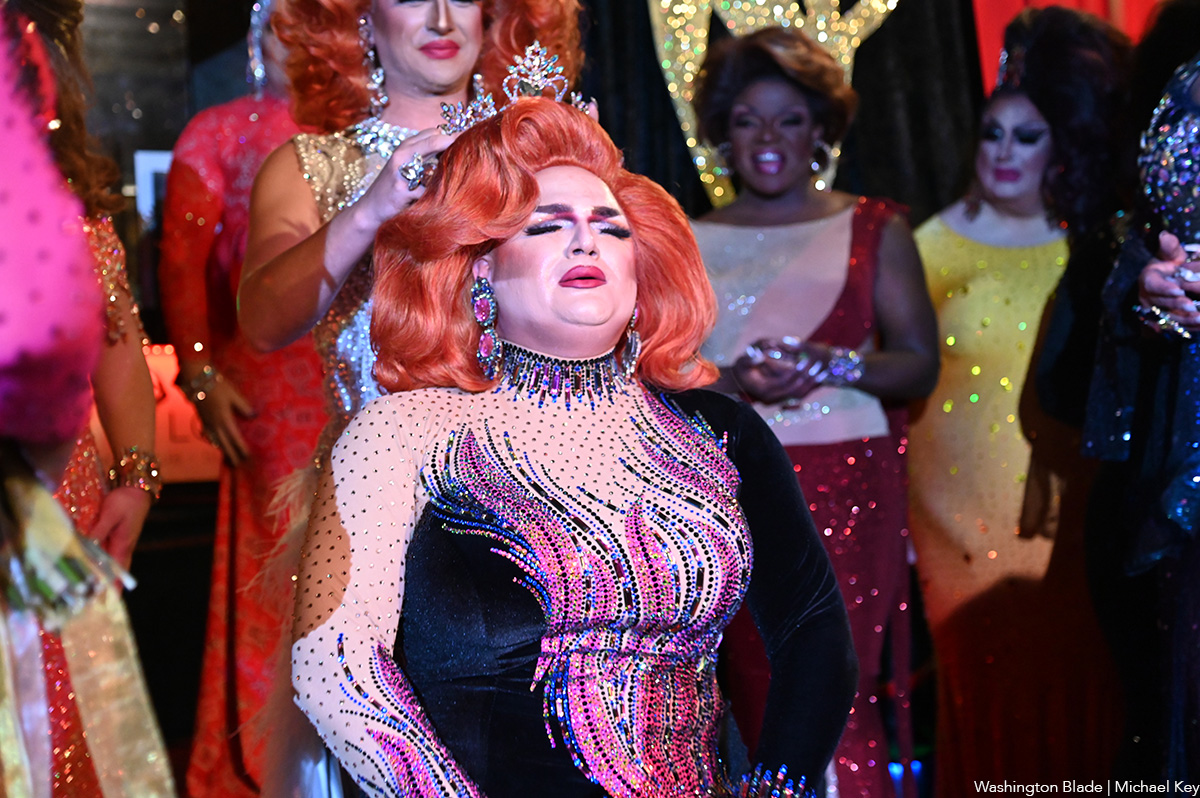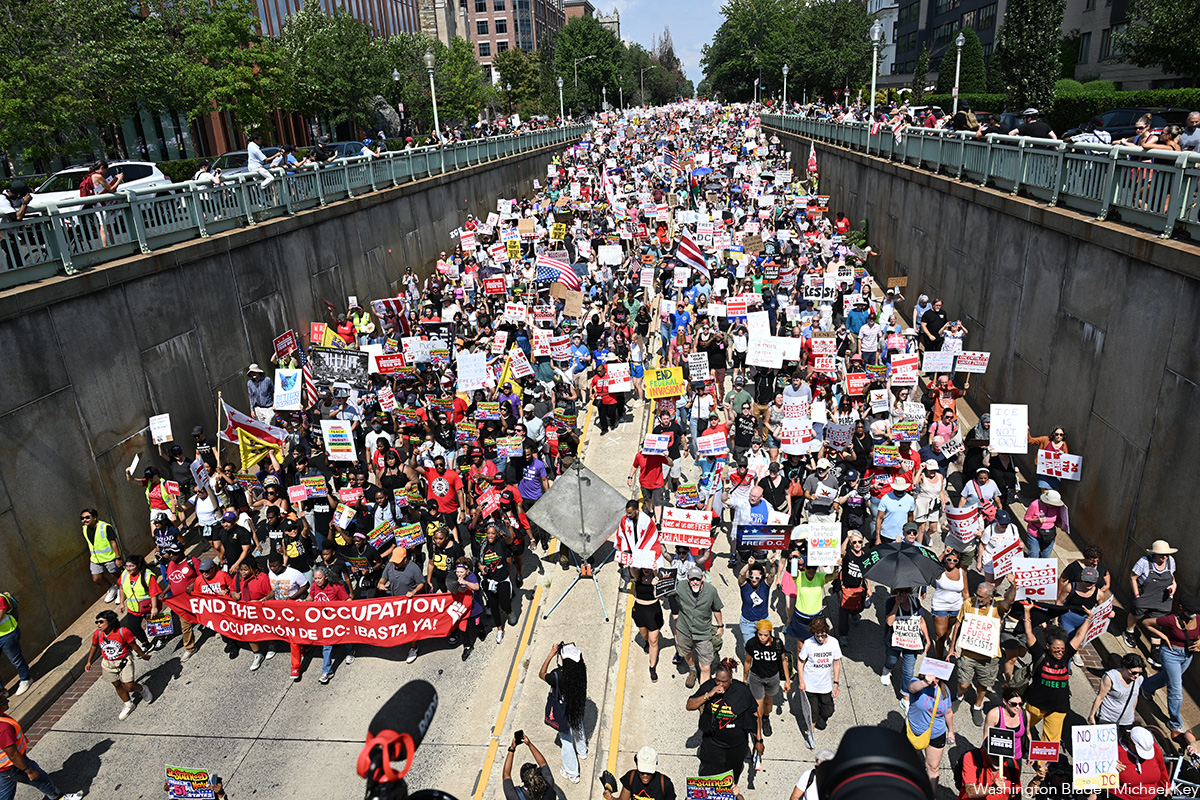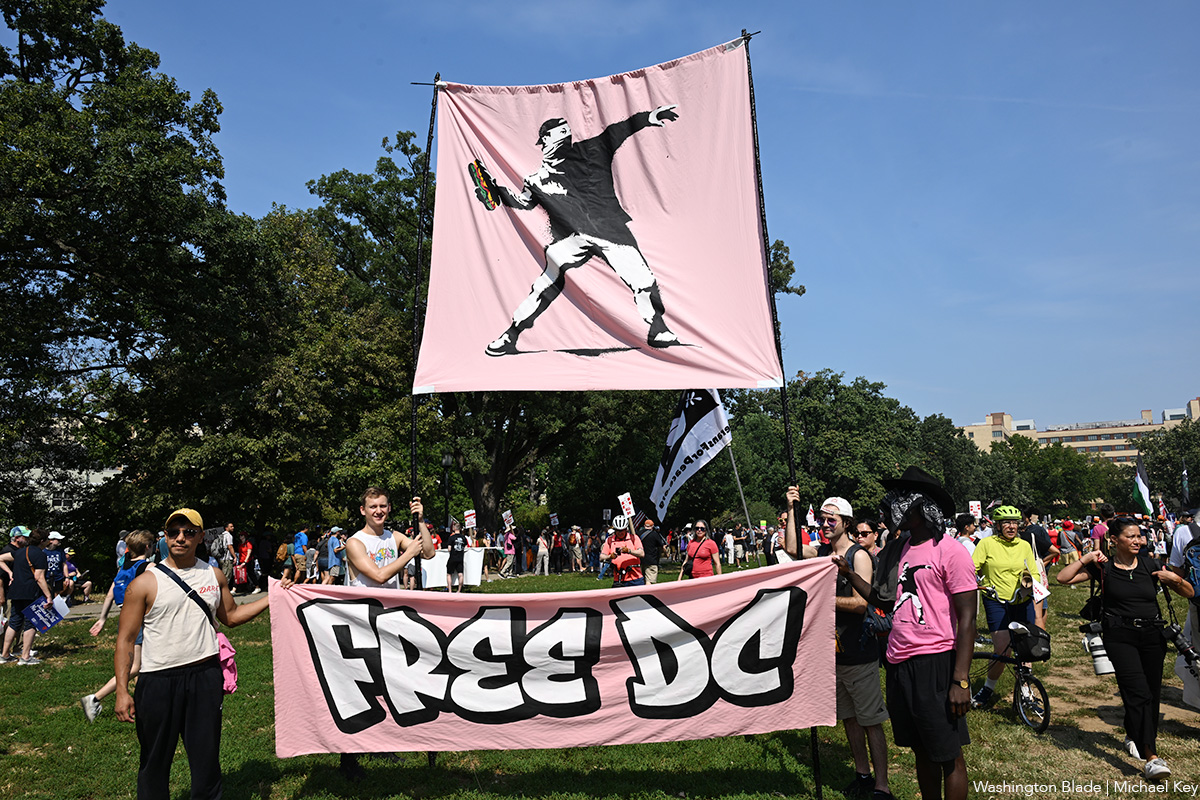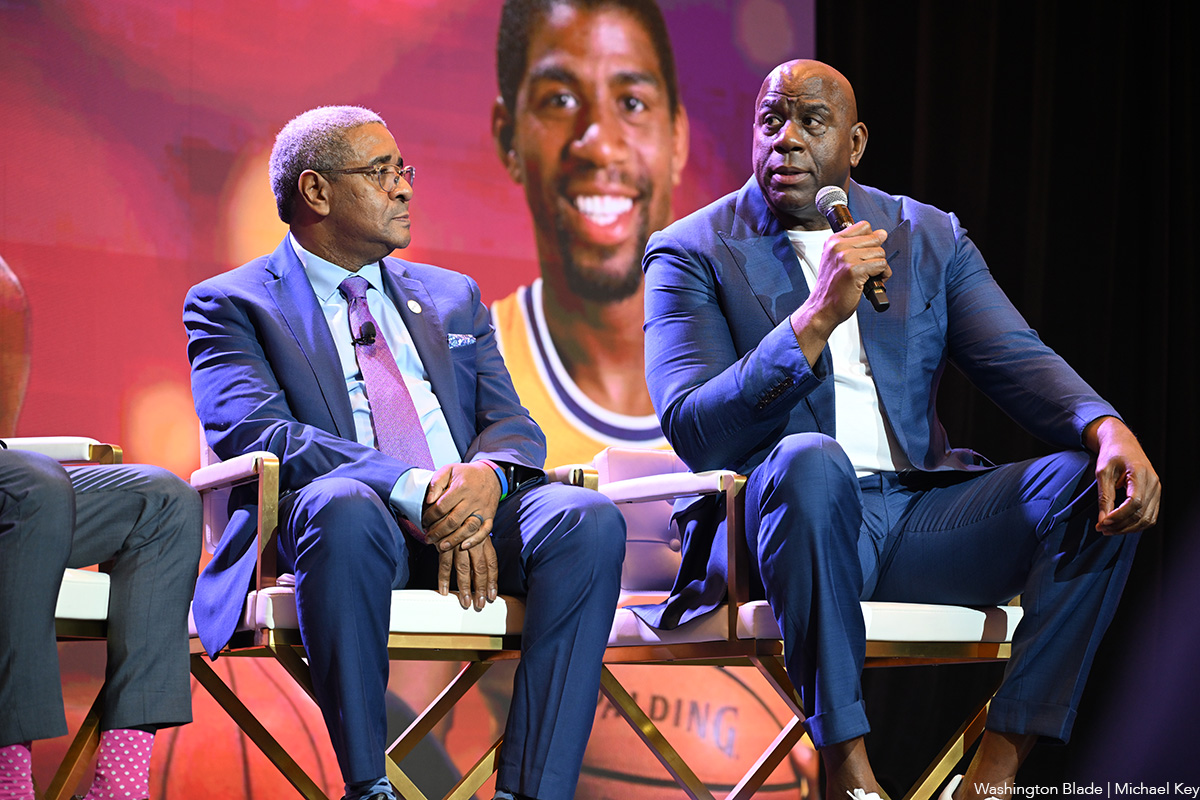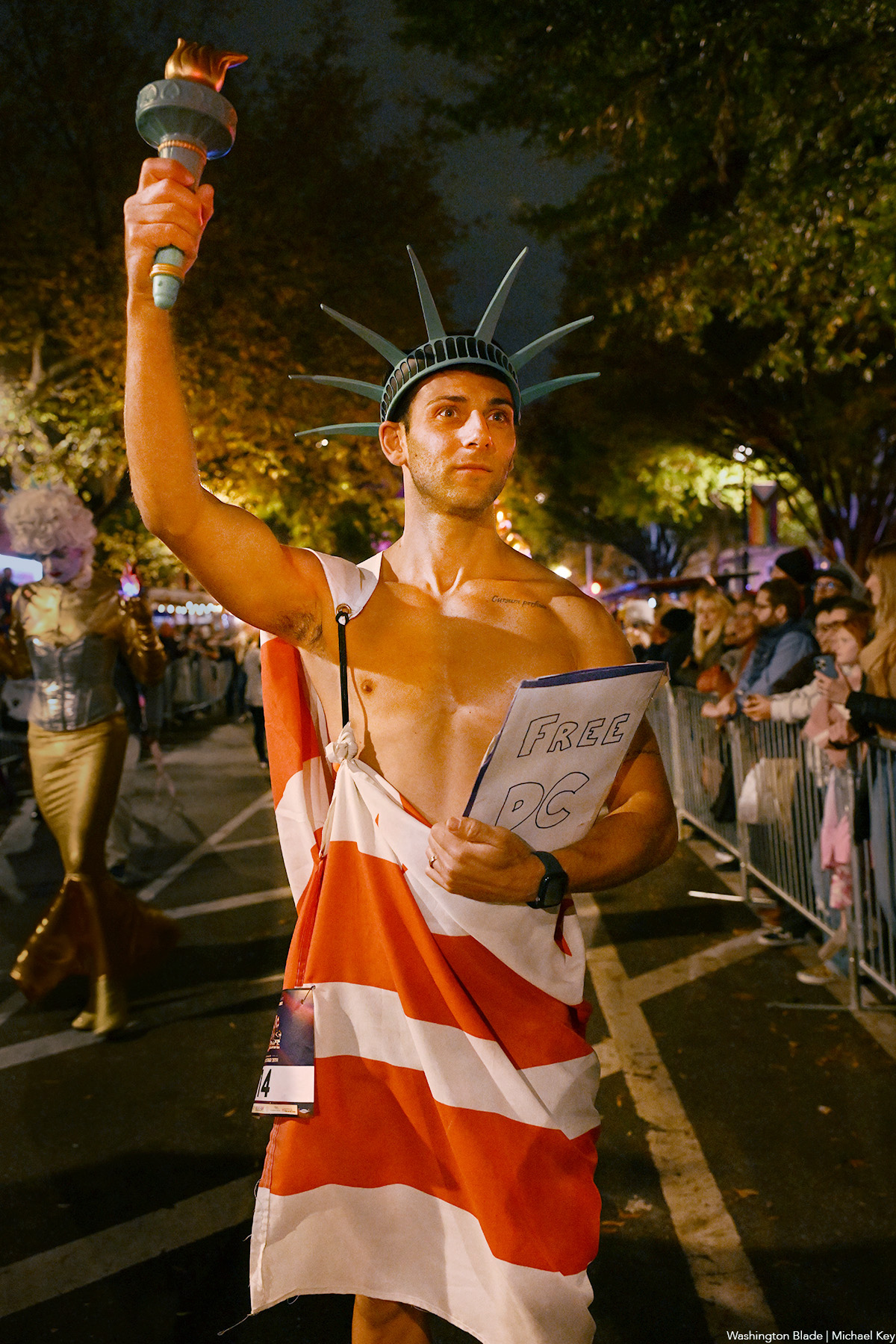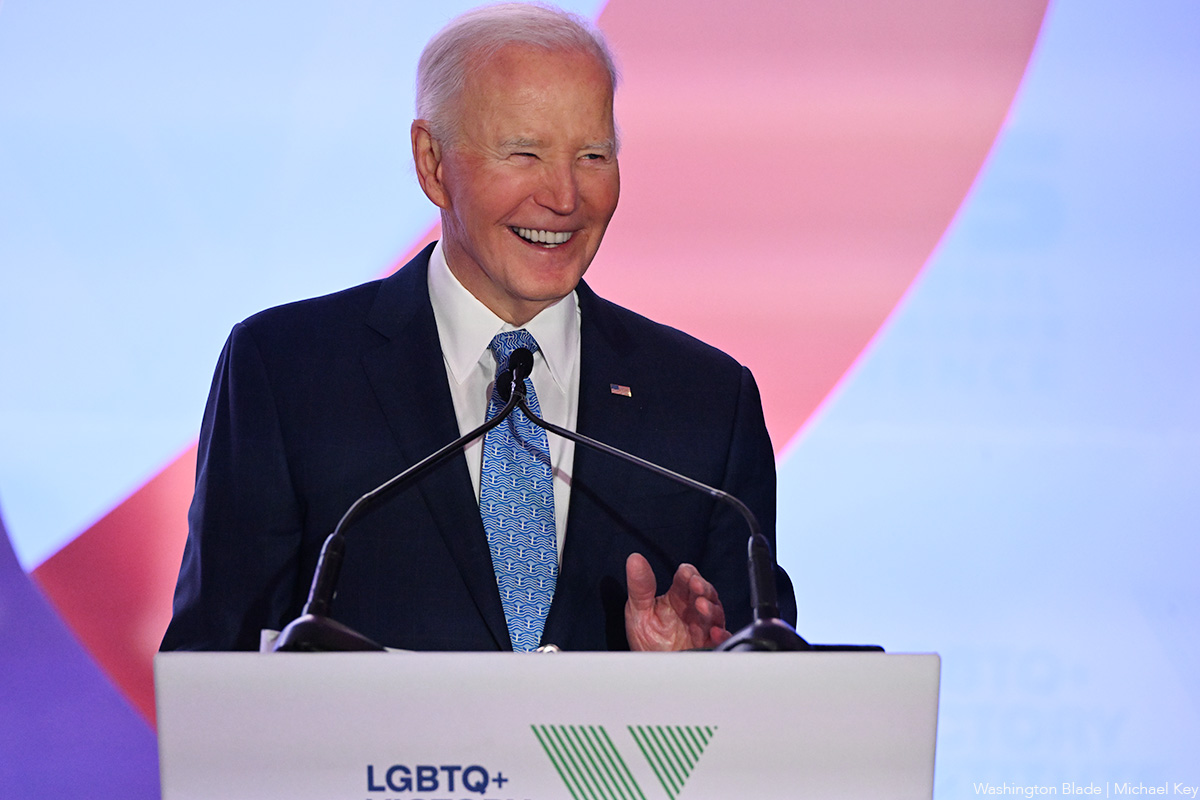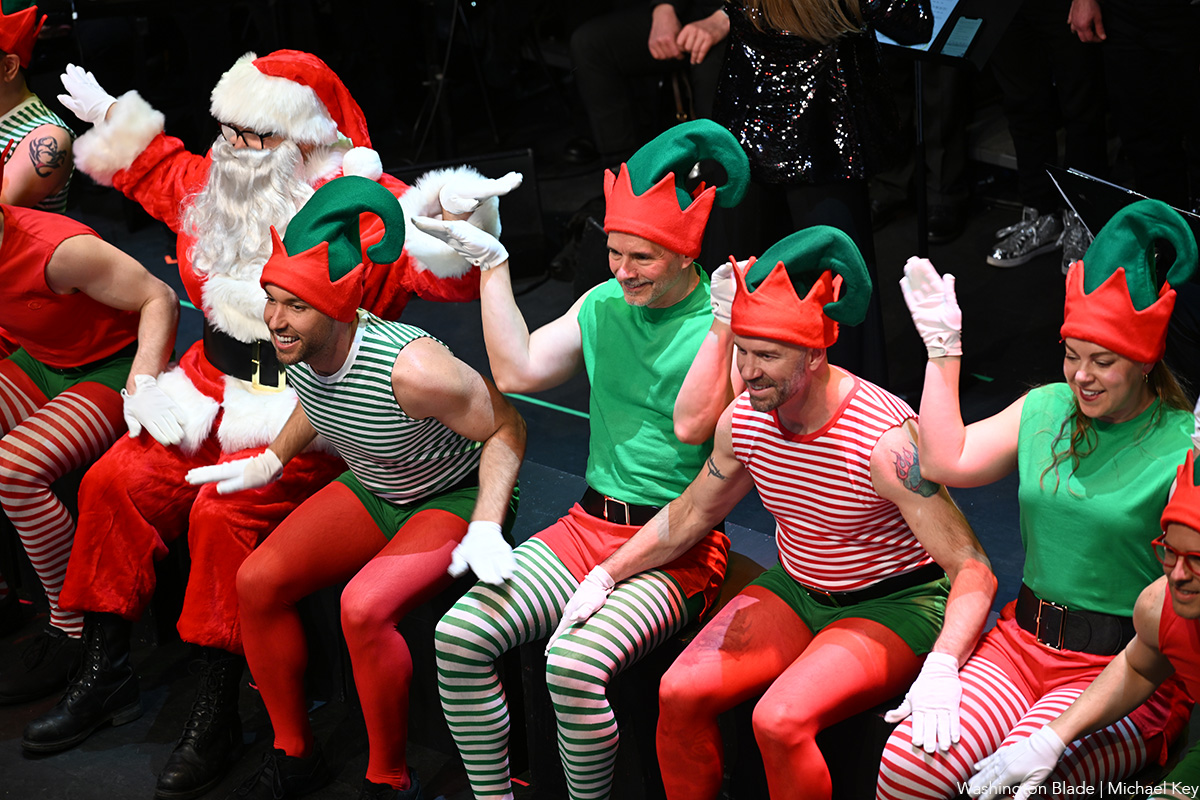Arts & Entertainment
AIDS and the arts
From the Quilt to Hollywood to Broadway, pop culture helped us make sense of grief, loss
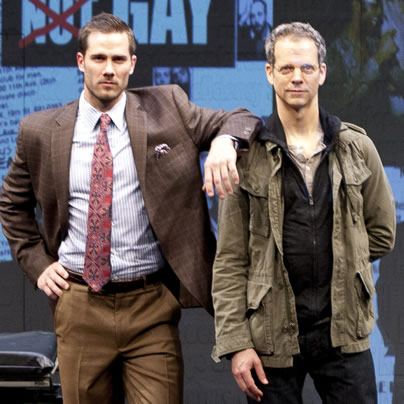
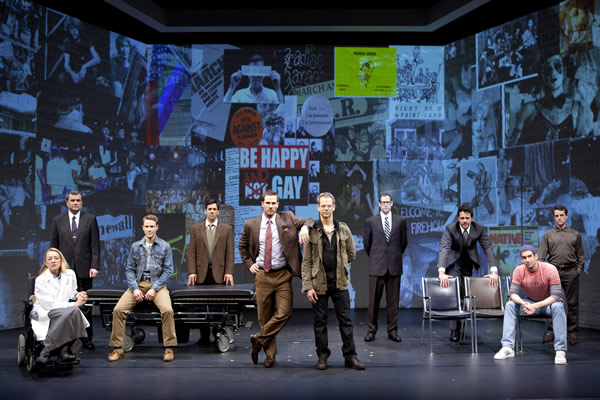
The cast of ‘The Normal Heart’ at Arena Stage. The show, a groundbreaking dramatization of the early years of the AIDS crisis in New York, runs through July 29. (Photo by Scott Suchman; courtesy Arena)
The International AIDS Conference in Washington offers an opportunity to look back at how artists have responded to the disease. Since the very first days of the crisis, artists of all kinds have actively responded, both in their artistic works and as fundraisers and activists.
THE NAMES PROJECT AIDS MEMORIAL QUILT
The Names Project AIDS Memorial Quilt, on display throughout the city through the month of July, is the largest community art project in the world. More than 48,000 panels have been created by lovers, family members and friends to memorialize those who have died of AIDS. The Quilt has redefined the traditional folk-art of quilt-making into a modern art form that serves as a memorial, a tool for education, a work of art and a call to arms. Each of the panels has been photographically preserved in the AIDS Memorial Quilt Archive. About 14 million around the world have seen panels from the Quilt.
The Quilt has its root in a powerful piece of political theater. While preparing for the annual candlelight march honoring Harvey Milk and George Moscone in 1985, San Francisco activist Cleve Jones was shocked to learn that more than 1,000 people in the city had already died of AIDS. He asked his friends to bring placards with the names of the dead to the march. After the march, the activists taped the placards to the side of the San Francisco Federal Building and realized that the signs now looked like a patchwork quilt. Inspired by the sight, Jones and his friends made plans for a larger memorial and in 1986 Jones created the first quilt panel in honor of his friend Marvin Feldman.
THE ART OF ACTIVISM
One of the remarkable features of the fight against AIDS has been the ability to use visual art to generate a powerful public response. This was especially true for the AIDS Coalition to Unleash Power (ACT UP), an international direct action advocacy group that worked to impact the lives of people with AIDS. Founded in New York City in 1987, the leaderless anarchist network effectively combined powerful direct action protests with provocative visual images to effectively generate media attention for their cause.
Veteran media activist Cathy Renna, who describes herself as “coming out and coming of age” when ACT UP was forming, says the global impact of the group came from its ability to use visual art to drive home a message.
“They had people like Ann Northrup and Larry Kramer who understood the media really well and who understood the power of images,” Renna says. “They created iconic images that demanded the attention of the media and became embedded in the minds of people.”
Renna notes that the members of ACT UP really showed the power of visual art to move people and the power of creativity and humor to reach people.
“Not everyone agreed with their tactics, but at the end of the day none of us can argue with the indelible impact they had on the public perception of AIDS and the entire LGBT movement,” she says.
CLASSICAL MUSIC
For centuries, there’s been a debate about how well classical music can respond to specific cultural events. Gay composer John Corigliano leapt into this fray when he wrote his Symphony No. 1 in 1991 as a response to the AIDS epidemic.
“During the past decade I have lost many friends and colleagues to the AIDS epidemic, Corigliano writes in his notes to the first recording of the symphony. “My First Symphony was generated by feelings of loss, anger and frustration.”
Corigliano, best known for his opera “The Ghost of Versailles” and his Oscar-winning score for “The Red Violin,” says that the form of his AIDS symphony was inspired by a viewing of the NAMES Project AIDS Memorial Quilt.
“A few years ago I was extremely moved when I first saw ‘The Quilt,’ an ambitious interweaving of several thousand fabric panels, each memorializing a person who had died of AIDS, and most importantly, each designed and constructed by his or her loved ones,” he wrote. “This made me want to memorialize in music those I have lost, and reflect on those I am losing.”
THEATER
Perhaps no other artistic medium has been as responsive to the AIDS crisis as theater. From ground-breaking pieces like Larry Kramer’s “The Normal Heart” (an Arena Stage production runs through July 29) and William Hoffman’s “As Is” to such recent works as “The Book of Mormon.” The theatrical community has been deeply involved in the artistic and activist response to AIDS. Here’s a sampling of plays and musicals that have AIDS as a central theme.
“Angels in America: A Gay Fantasia on National Themes.” Part One of Tony Kushner’s sprawling epic (“Millennium Approaches”) opened on Broadway in May 1993, and Part Two (“Perestroika”) followed in November of that year. The play centers on Prior Walter, a gay man in Manhattan who has just been diagnosed with AIDS as the play opens. Over the course of the seven-hour theatrical extravaganza, Prior is abandoned by his lover Louis, who leaves him for a closeted Republican lawyer; befriends the Mormon’s mother and wife, who takes Valium in “wee little fistfuls,” is nursed by his ex-lover, the fierce snap queen Belize; and, is visited by an angel who wants to recruit him as a prophet. The play won the Pulitzer Prize and several Tony Awards and was adapted into both an award-winning movie by HBO Films and an opera by Hungarian composer Péter Eötvös.
“The Normal Heart” by Larry Kramer was one of the earliest plays to deal with AIDS. Now playing at Arena Stage, the play is a thinly veiled autobiography of the author and the founding of Gay Men’s Health Crisis.
“Before It Hits Home” by Cheryl West was one of the first dramas to focus on the impact of AIDS on the African-American community. Wendal is a bisexual jazz musician who denies his sexual encounters with men even after he is diagnosed with AIDS. He tries to hide the truth from his pregnant girlfriend and his married boyfriend, but as his health deteriorates, he is forced to return to his family and confess the truth.
“Rent” is Jonathan Larson’s hit musical and a loose adaptation of Puccini’s “La Boehme” set on the lower East Side of Manhattan in the early 1980s. Larson’s musical landscape includes a variety of artists in a variety of straight and LGBT sexual situations. Many of the characters have AIDS and the Act II opener, “Seasons of Love” has become a popular anthem for the fight against AIDS.
The musical “Falsettos,” produced in Washington in 2010 by the now-closed Ganymede Arts, brings together two one-act musicals by William Finn written a decade apart. In “March of the Falsettos,” Marvin moves in with his male lover Whizzer, much to the distress of his ex-wife, his psychiatrist and his son. In “Falsettoland,” the extended family, now including “the lesbians from next door,” reunite to support Whizzer and Marvin as they deal with an AIDS diagnosis.
Perhaps most noticeably in theater, it’s possible to also trace how AIDS dramas have evolved over the years.
“’The Normal Heart’ was so significant in its time, but it’s dated now because the disease has changed so much,” says David Jobin, executive director of the Gay Men’s Chorus of Washington, a group that along with its sister choruses has also dealt extensively with AIDS themes. “You see plays now, like ‘Octopus’ by Steve Yockey and it’s dealing with how different generations have responded to the crisis. We now have a whole generation of people whose experience is different and it’s not about loss at all. … all people could concentrate on in ‘The Normal Heart’ was grieving, so it’s become like ‘The Dollhouse,’ a great period piece but not really relevant to today. Which is great in a way that something that’s only 20 years old can already seem so dated. It shows how far we’ve come in treating the disease.”
Jobin says the greatest examples of AIDS-themed art transcend their subject matter.
“You watch something like the HBO adaptation of ‘Angels in America,’ and it becomes so much more than just a statement about AIDS,” he says. “It’s a tour de force for great acting and it’s in a league of its own. I can’t think of a musical or other work that even comes close.”
ARTISTS AS ACTIVISTS
The theatrical community, and the performing arts community in general, have also been incredibly effective at blending art and activism. For example, since 1987 Broadway Cares/Equity Fights AIDS has been raising awareness and funds for AIDS organizations throughout the country. Their popular fundraisers include Broadway Bares, Broadway Barks, Broadway Bears, the annual Easter Bonnet and Gypsy of the Year competitions and the Fire Island Dance Festival.
One of the group’s most effective efforts has been its collaboration with the International Thespian Society, a national network of high school theater troupes. Starting in 1999, high school thespians have organized audience appeals, bucket brigades, silent auctions and special performances to raise money to fight AIDS.
During their annual festival in July 2012, Joe Norton, Broadway Cares’ director of education and outreach, announced that the student artists and activists had raised more than $1 million to support organizations in their communities.
“Thespians know how to effect change by working together and celebrating their love of theater,” Norton says. “And, in the process, they become leaders who raise awareness about HIV/AIDS where they live, while making a difference for so many people in need in their local communities and around the country.”
TELEVISION
Sometimes the artistic response to AIDS has been more about context than content. The popular nighttime ABC soap opera “Dynasty” was groundbreaking in its portrayal of Steven Carrington, the openly gay son of a wealthy Denver oil clan. But its role in the emerging AIDS crisis was due to an off-screen drama.
In 1984, closeted gay Hollywood icon Rock Hudson was cast as Daniel Reece, father of the scheming Sammy Jo Carrington (Heather Locklear). Hudson’s character had a romantic interest in Krystle Carrington, played by series star Linda Evans. Although viewers gossiped about Hudson’s gaunt appearance and producers were worried enough about Hudson’s health to write his character out of the series, no one blinked an eye when Hudson and Evans shared an on-screen kiss.
That changed on July 25, 1985 when Hudson publicly announced that he had AIDS, the first celebrity to reveal his HIV status. He learned that he had AIDS while he was appearing on “Dynasty,” and the soap set suddenly became the focus of a public health controversy. The CDC warned the public about exchanging saliva with members of high-risk groups. Aaron Spelling and the producers of “Dynasty” offered to arrange for AIDS tests for the entire cast. The Screen Actors Guild wrote new rules to regulate on-screen kisses.
Hudson’s revelation, and the subsequent revelation of his homosexuality, suddenly put a public face on the disease and his death on Oct. 2, 1985 set the stage for the first television movie on AIDS. On Nov. 11, 1985, NBC broadcast “An Early Frost” starring Aidan Quinn as Michael Pearson, a successful Chicago lawyer who has not told his colleagues and family about his lover Peter Hilton (D.W. Moffett). When he’s diagnosed with AIDS, he’s forced to go home and tell his family the truth about himself.
MOVIES
A short sampler of independent and mainstream movies that have dealt directly with the AIDS crisis include:
“Parting Glances,” Bill Sherwood’s moving 1986 indie film that was one of the first to deal with AIDS. Richard Ganoung plays Michael who is dealing with concurrent crises: caring for his ex-lover Nick (Steve Buscemi) while his lover Robert (John Bolger) is preparing to leave for a two-year work assignment in Africa.
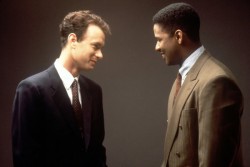
Tom Hanks (left) and Denzel Washington in ‘Philadelphia,’ a 1993 AIDS-themed Jonathan Demme movie. (Still courtesy TriStar Pictures)
“Philadelphia,” Jonathan Demme’s 1993 drama that was among the first mainstream Hollywood movies to deal with AIDS. Tom Hanks won a Best Actor Oscar for his performance as Andrew Beckett, a closeted lawyer who is fired from his conservative law office when his partners learn he has AIDS. Denzel Washington plays Joe Miller, a homophobic lawyer who helps Beckett sue his former law firm.
“Longtime Companion,” is a 1990 film that takes its title from the homophobic term used by the New York Times and other newspapers to refer to the surviving partners of deceased gay men. It chronicles the early years of the AIDS epidemic from the 1981 article on the mysterious disease occurring among gay men to the beginnings of AIDS activism.
“Tongues Untied” is Marlon Riggs’ stunning 1989 film sought to “shatter the nation’s silence on matters of sexual and racial difference.” It combines documentary footage with fictional stories and episodes from Riggs’ life, as well as footage from civil rights marches and a homophobic stand-up routine by comedian Eddie Murphy.
FICTION
Since the 1980s, countless novelists have tackled the topic of AIDS. From early efforts, such as Armistead Maupin’s “Tales of the City” series to recent books such as Edmund White’s “Jack Holmes and His Friend,” the novel has been a fertile ground for exploring the devastating impact of AIDS on individuals and their society.
One of the most controversial has been “People in Trouble” by lesbian writer and activist Sarah Schulman. The novel deals with a love triangle among artists in the East Village. The controversy, however, arose from Schulman’s accusation that Jonathan Larson lifted the gay plot of “Rent” from her novel. In her 1998 book “Stagestruck: Theater, AIDS and the Marketing of Gay America,” she details the similarities between the two works and critiques how Larson depicts LGBT people and people with AIDS.
Examples
THEATER
Terrence Mc Nally, “Love! Valour! Compassion!”
Cheryl West, “Before It Hits Home”
William Finn, “Falsettos”
William Hoffman, “As Is”
Jonathan Larson, “Rent”
Paula Vogel, “The Baltimore Waltz”
Paul Rudnick, “Jeffrey”
Harvey Fierstein, “Safe Sex”
Larry Kramer, “The Normal Heart” and “The Destiny of Me”
Tony Kushner, “Angels in America”
Robert Lopez, Matt Stone and Trey Parker, “The Book of Mormon”
Broadway Cares/Equity Fights AIDS
POETRY
Mark Doty, “My Alexandria”
Essex Hemphill, “Ceremonies”
Marie Howe, “What the Living Do”
Paul Monette, “Love Alone: 18 Elegies for Rog”
Rafael Campo, “What the Body Told”
Tim Dlugos, “Powerless”
Tory Dent, “What Silence Equals”
TELEVISION
“An Early Frost”
“Dynasty”
“Another World”
“As The World Turns”
“Common Threads: Stories from the Quilt”
“And The Band Played On”
“The Real World”
“Any Mother’s Son”
“In The Gloaming”
FICTION
Christopher Bram, “In Memory of Angel Clare”
Sarah Schulman, “People in Trouble”
Alice Hoffman, “At Risk”
Armistead Maupin, “Tales of the City”
Paul Monette, “Afterlife”
Edmund White, “Jack Holmes and his Friend”
Dale Peck, “Martin and John”
E. Lynn Harris, “Invisible Life”
Felice Picano, “Like People in History”
Sapphire, “Push”
David B. Feinberg, “Spontaneous Combustion”
Samuel R. Delaney, “The Tale of Plagues and Carnivals”
Geoff Ryman, “Was”
CLASSICAL MUSIC
John Corigliano, “Symphony No. 1”
“Classical Action”
MUSIC
“NakedMen”
“Exile”
“Metamorphosis”
“In This Life” by Madonna (from “Erotica”)
ARTS ACTIVISM
ACT UP
Broadway Cares
Names Project AIDS Memorial Quilt
ESSAY
Susan Sontag, “AIDS and Its Metaphors”
Larry Kramer, “The Tragedy of Today’s Gays”
MEMOIRS
Paul Monette, “Borrowed Time”
Reinaldo Areñas, “Before Night Falls”
Mark Doty, “Heaven’s Coast”
Derek Jarman, “At Your Own Risk”
Jamaica Kincaid, “My Brother”Paula W, Peterson, “Women in the Grove”
John Preston, “Winter’s Light”
David Wojnarowicz, “In the Shadow of the American Dream”
PERFORMANCE ART
Ron Athey
Ron Vawter
David Drake
MOVIES
“Longtime Companions”
“Parting Glances”
“Paris is Burning”
“Philadelphia”
“Patient Zero”
“The Living End”
“The Hours”
“It’s My Party”
“Tongues Untied”
VISUAL ARTS
Visual AIDS
Keith Haring
ACT UP and Gran Fury
DANCE
Bill T. Jones, Absence
Neil Greenbery, Not-About AIDS-Dance
UCLA Dance Marathon
Dancers Responding to AIDS
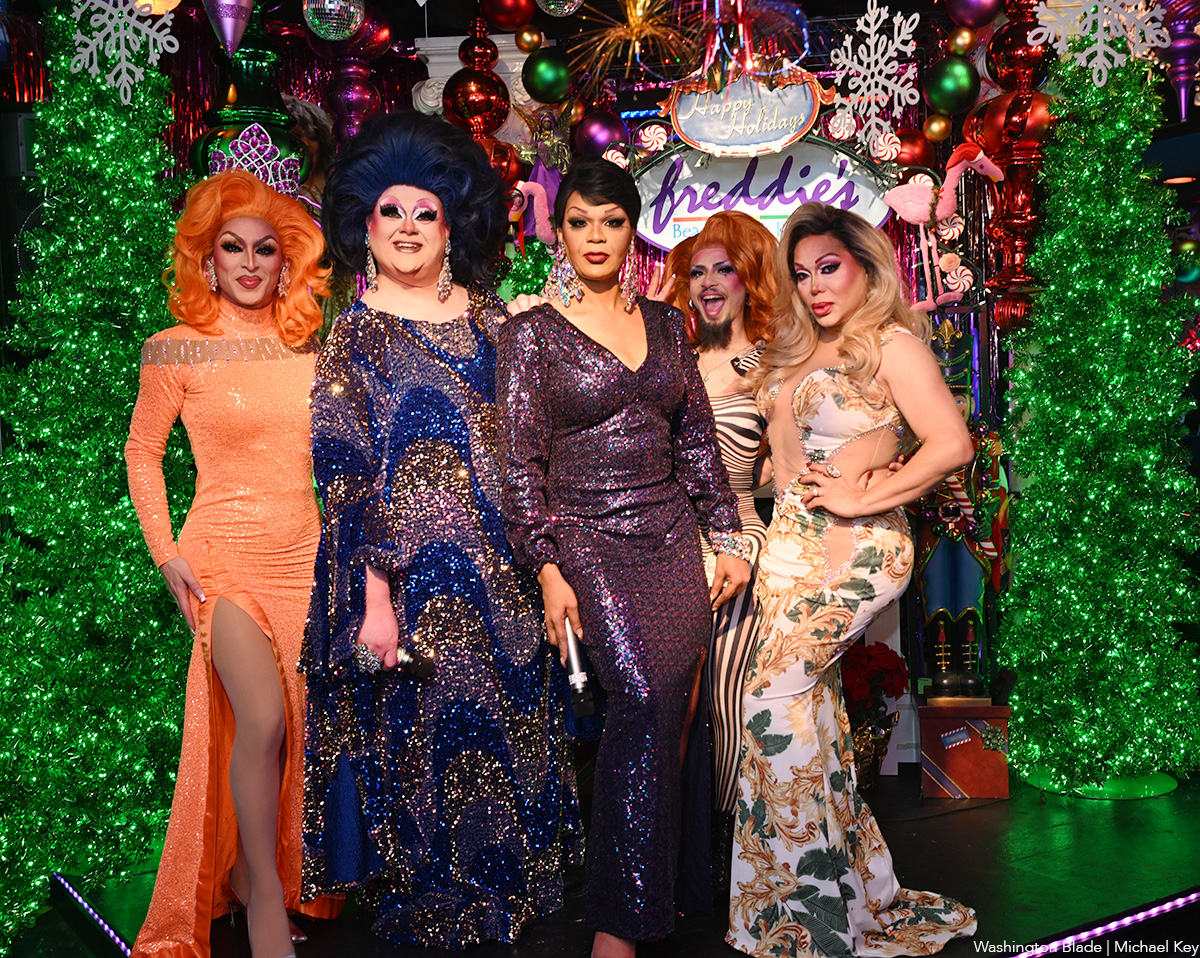
The Freddie’s Follies drag show was held at Freddie’s Beach Bar in Arlington, Va. on Saturday, Jan. 3. Performers included Monet Dupree, Michelle Livigne, Shirley Naytch, Gigi Paris Couture and Shenandoah.
(Washington Blade photos by Michael Key)

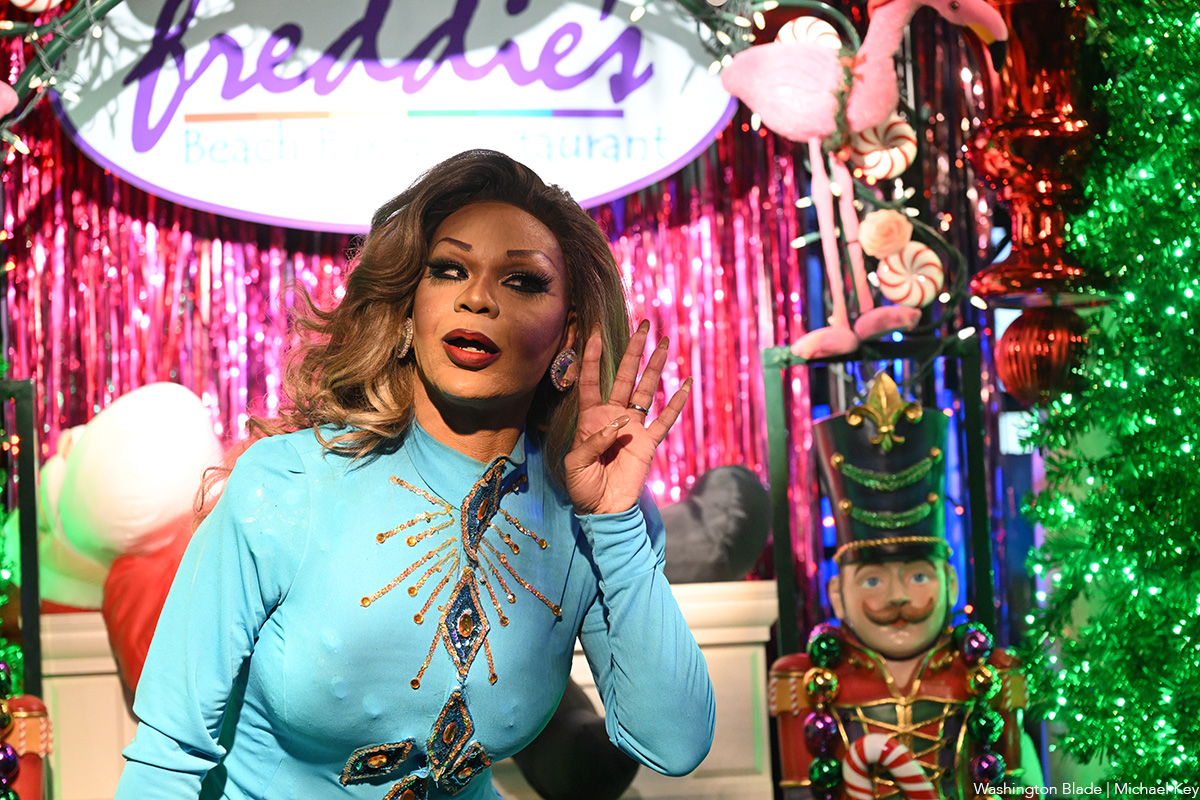








a&e features
Queer highlights of the 2026 Critics Choice Awards: Aunt Gladys, that ‘Heated Rivalry’ shoutout and more
Amy Madigan’s win in the supporting actress category puts her in serious contention to win the Oscar for ‘Weapons’

From Chelsea Handler shouting out Heated Rivalry in her opening monologue to Amy Madigan proving that horror performances can (and should) be taken seriously, the Critics Choice Awards provided plenty of iconic moments for queer movie fans to celebrate on the long road to Oscar night.
Handler kicked off the ceremony by recapping the biggest moments in pop culture last year, from Wicked: For Good to Sinners. She also made room to joke about the surprise hit TV sensation on everyone’s minds: “Shoutout to Heated Rivalry. Everyone loves it! Gay men love it, women love it, straight men who say they aren’t gay but work out at Equinox love it!”
The back-to-back wins for Jacob Elordi in Frankenstein and Amy Madigan in Weapons are notable, given the horror bias that awards voters typically have. Aunt Gladys instantly became a pop culture phenomenon within the LGBTQ+ community when Zach Cregger’s hit horror comedy released in August, but the thought that Madigan could be a serious awards contender for such a fun, out-there performance seemed improbable to most months ago. Now, considering the sheer amount of critics’ attention she’s received over the past month, there’s no denying she’s in the running for the Oscar.
“I really wasn’t expecting all of this because I thought people would like the movie, and I thought people would dig Gladys, but you love Gladys! I mean, it’s crazy,” Madigan said during her acceptance speech. “I get [sent] makeup tutorials and paintings. I even got one weird thing about how she’s a sex icon also, which I didn’t go too deep into that one.”
Over on the TV side, Rhea Seehorn won in the incredibly competitive best actress in a drama series category for her acclaimed performance as Carol in Pluribus, beating out the likes of Emmy winner Britt Lower for Severance, Carrie Coon for The White Lotus, and Bella Ramsey for The Last of Us. Pluribus, which was created by Breaking Bad’s showrunner Vince Gilligan, has been celebrated by audiences for its rich exploration of queer trauma and conversion therapy.
Jean Smart was Hack’s only win of the night, as Hannah Einbinder couldn’t repeat her Emmy victory in the supporting actress in a comedy series category against Janelle James, who nabbed a trophy for Abbott Elementary. Hacks lost the best comedy series award to The Studio, as it did at the Emmys in September. And in the limited series category, Erin Doherty repeated her Emmy success in supporting actress, joining in yet another Adolescence awards sweep.
As Oscar fans speculate on what these Critics Choice wins mean for future ceremonies, we have next week’s Golden Globes ceremony to look forward to on Jan. 11.
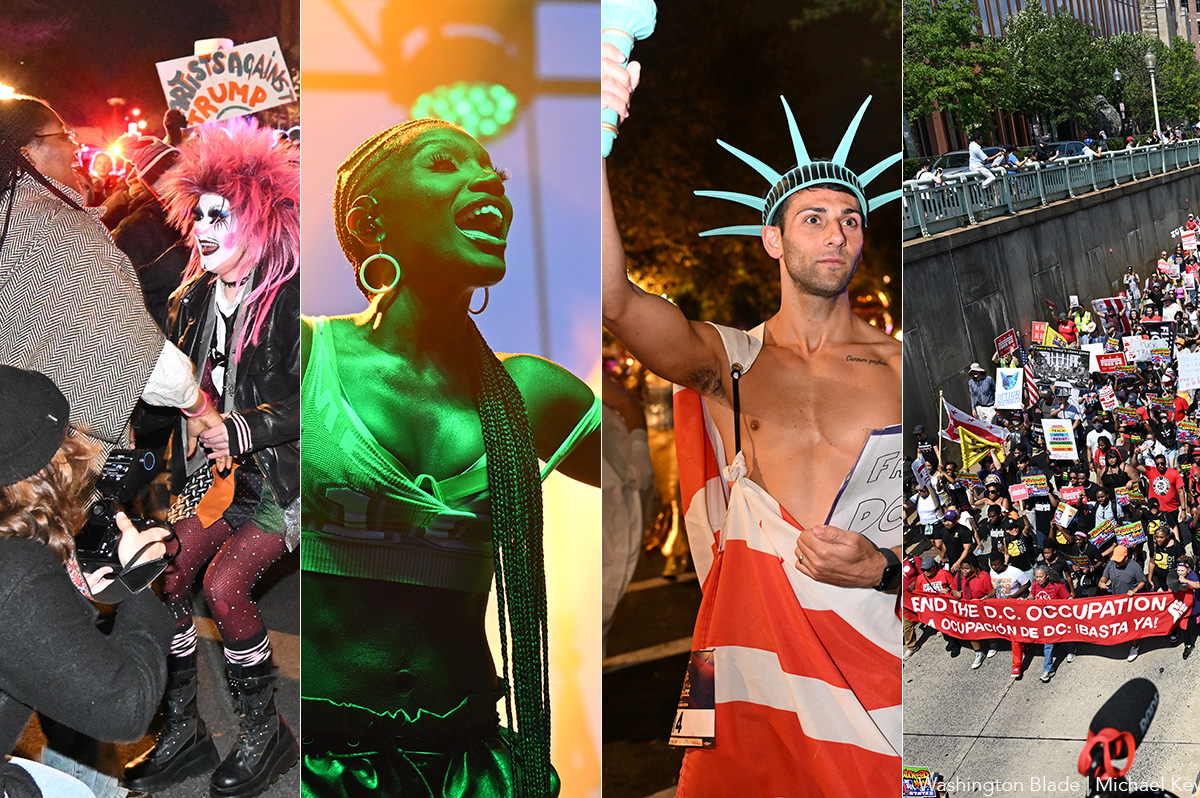
(Washington Blade photos by Michael Key)
